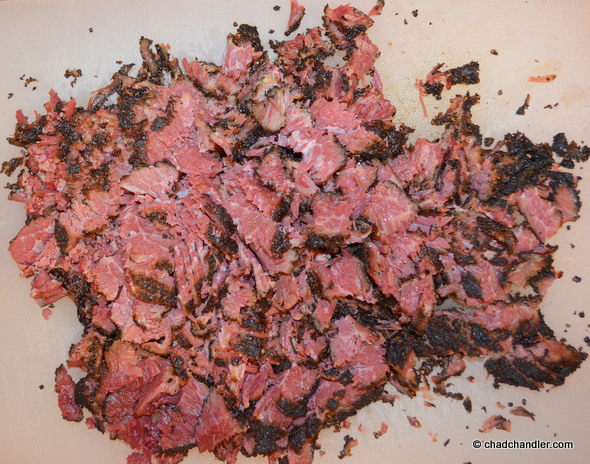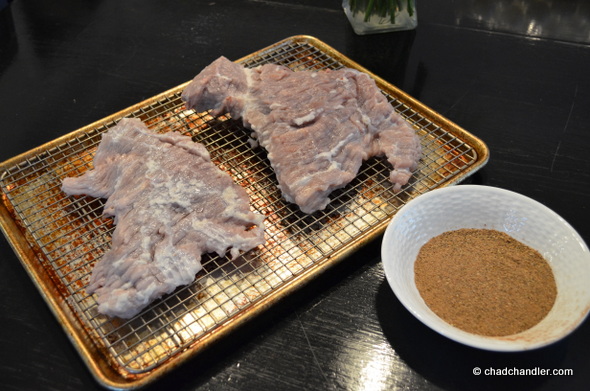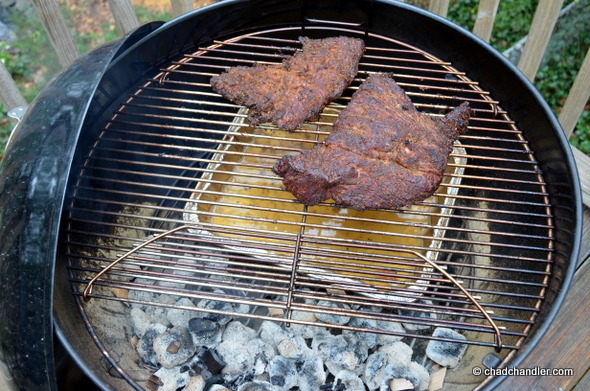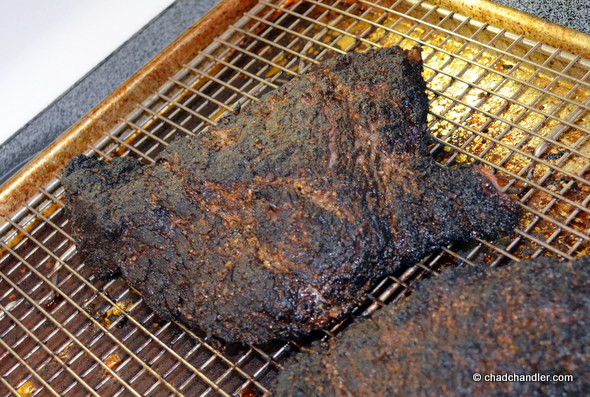
I’m a huge fan of corned beef and pastrami. Most people don’t realize that pastrami is just corned beef that has been rubbed and smoked. My problem with grocery store deli pastrami is that the meat is mushy, the fat at the edges is chewy like a rubber band, and the spice rub is pretty bland. So I decided to make my own. In a recent post, I detailed how to make corned beef from scratch. Now I’ll cover the process of turning corned beef into great pastrami.
I used the point cut of the brisket for this recipe because it’s fattier than the flat cut. I trimmed off almost all of the fat cap. Almost everyone leaves a thin layer of fat cap on their meats before smoking. I think that just results in a greasy bark, so I don’t do it. The high fat ratio in the meat renders and adds plenty of flavor when it’s smoked.
The point is bisected by a thick layer of fat. Some people smoke the point as one piece and either scrape the fat it out later with a knife or don’t bother removing it at all. I removed the fat before smoking because of three reasons:
- It doubles the number of surfaces I can rub and smoke.
- The cuts will cook faster.
- The wife is a very picky eater.
You should see the way the wife cuts around fat on a ribeye or a pork chop. It’s positively sinful.
If you cut the point into two pieces, remember to use less rub than you would for a thicker piece of meat. I started with corned beef that’s been cured, but not cooked. That means it’s still tough. After the brining, I sat the point cut in a bucket of water for a day to desalinated it. Then I rubbed it. If you’re starting with a store-bought package of corned beef, this is where you will begin as well.

I used a rub recipe (cut in half) from AmazingRibs.com. Their recipe is supposed to approximate the flavor of the pastrami from Katz’s Deli in NYC.
Pastrami Rub
- 2 tablespoons coarsely ground black pepper
- 1 tablespoons ground coriander
- 1½ tablespoons brown sugar
- 1½ tablespoons paprika
- 1 teaspoon garlic powder
- 1 teaspoon onion powder
- ½ teaspoon mustard powder
Use a spice grinder or a mortar and pestle to grind the rub. Rub it into all of the nooks and crannies of the meat.

After applying the rub, I placed the beef into a zip top bag and refrigerated it for five days. Some people argue that it’s essential to let the rub tenderize the meat in the fridge, but I’ve never found that to be necessary. I only did it this time because I didn’t have time to smoke the meat until the weekend.
Create a two-zone fire and cook the pastrami using indirect heat over a drip pan. This is my standard barbecue set-up, although I need to buy another thermometer to properly measure the grate temperature. You can learn more about my set-up here: How To Make Perfect Pulled Pork BBQ.

Smoke the meat between 210–250° until the internal temperature reaches around 190°. Ideally, you want to keep the temperature an even 225° for the entire process, but that’s the trick, isn’t it? The beef is cured, so you’re worried less about maintaining a safe cooking temperature than you are about the wetness and tenderness of the meat.
The faster the meat rises in temperature, the more connective tissue remains in the meat when it’s done. The slower the temperature rises, the more those tissues breaks down. But the longer you cook the meat, the greater the chance that it’ll dry it out. There’s a balance to be maintained and finding that balance requires experience.
The cook time depends on the size and weight of the meat, but plan for around three hours if you’ve cut the point in half. Double that if you left it in once piece or used a store-bought corned beef (usually from the flat cut). Rotate the pastrami away from the heat source every hour or so and flip it over at least once so that the juices baste the meat evenly. Smoke it the entire time. I used a combination of fruit woods.
This is what it looks like when it’s finished cooking. Check out that bark.

Restaurants like Katz’s and Carnegie Deli smoke huge batches of pastrami and then refrigerate them for later use. It’s usually served hot, so they toss the cooked pastrami into steam trays to keep them warm throughout the day. You don’t have to do that at home. You can just slice up the hot pastrami right out of the smoker. But the steaming process does make the meat more tender. So if you’re not happy with the texture of the pastrami, then steam it for an hour or two at 225°.
I had some family coming into town later that afternoon, so I figured I’d steam it at a lower-than-usual oven setting until they got here. When it’s ready to serve, allow the meat to rest for around 15 minutes before carving. The only thing left to do at this point is to slice it thinly against the grain and serve however you like. Some of my guests made pastrami reubens. I just had a pastrami and mustard sandwich.

This was really good, but the thinness of the cuts allowed the beef to dry out a bit. Next time, I’ll spend less time on the smoker and more time steaming in the oven.







U steam it w/the same pan U catch drippings?
If in oven that means top shelf, eh?
-cf